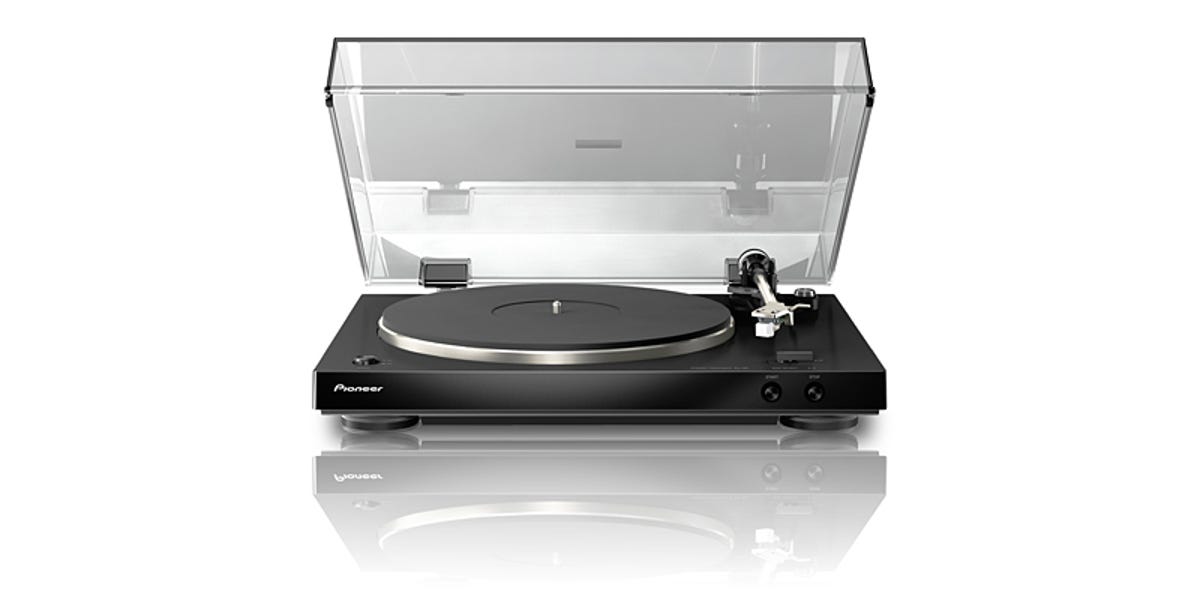
Pioneer
The ongoing surge in LP sales shows no signs of slowing down, but not everybody gets “it” — they don’t understand what the fuss is all about. Why has this ancient format not only stuck around long after digital should have buried it? What the hell is going on?
The answer is simply this: at its best, vinyl draws me into the music more than digital ever does. Vinyl listeners are more engaged, LPs somehow make music more enjoyable, but all bets are off if the turntable and/or phono cartridge are lacking. That’s where the new Pioneer PL-30-K turntable (US $299, UK £299) comes into play: it kept LP surface noise down to a minimum, speed stability was good, and it’s a fully automatic design. What does that mean? After you place a LP on the platter, press the start button, and the metal platter starts turning, the tonearm automatically moves into position just over the LP’s lead-in groove, then gently lowers the stylus onto the record to get the music going. Then, at the end of the LP side, the tonearm automatically lifts from the groove, moves over the record and returns to the arm rest. The PL-30-K then turns the platter motor off. The auto mechanism works smoothly; the PL-30-K performed flawlessly.
With “manual” turntables like the Pro-Ject Debut Carbon, Rega RP1 or U-Turn Orbit you have to do all the “work” yourself, and move the tonearm into position, lowering and raising it from the LP, and so forth by hand. Not only that, the PL-30-K has a built-in phono preamp. Those manual turntables I just mentioned do not. So with the PL-30-K you can plug it directly into almost any receiver, integrated amplifier, desktop speakers, or any portable speaker that has an analog stereo input jack.


Steve Guttenberg/CNET
PL-30-K setup is no biggie: place the metal platter over the turntable’s spindle, do a quick reach-around to thread the drive belt over the motor pulley, attach the tonearm’s counterweight, adjust the stylus tracking force, and you’re good to go. I had the PL-30-K up and playing tunes in under five minutes. The owner’s manual provides good information for first-time turntable buyers. I used my NAD C316BEE and an Onkyo A-9010 integrated amps for all of my listening tests.
The PL-30-K comes with an Audio-Technica 3600L moving-magnet cartridge. I was happy with its sound quality, but upgrading to an Ortofon 2M Red cartridge would be a smart move. I started listening with the PL-30-K’s build-in phono preamp, and the sound was fine. After 15 minutes I plugged-in my Schiit Audio Manipre-amplifier and that improved the sound. The Mani sells for $129 in the US, and UK pricing runs £112. It sounded even better and more full-bodied; dynamics kicked harder, and bass had more oomph than the PL-30-K’s internal phono preamp.
A 12-inch 45 RPM EP of the Smiths “The Peel Sessions” was vivid and totally alive sounding. That’s what’s great about vinyl on a good quality turntable: the music can blow you away. I’m not much of a Smiths fan — I found this one on the street a few years ago and rarely played it. It was in perfect shape, so I guess the original owner didn’t either, but I now love this short set of four tunes recorded on May 18, 1983.
That record led to Black Uhuru’s “The Dub Factor” LP, and its potent reggae beats lit up my room. Bass definition and punch were awfully good. The energy of the music, and the way the band dug into the tunes really grabbed me.
Late last year I reviewed Pioneer’s flagship PLK-1000 ‘table, and that’s still the one to get if you’ve already amassed a large LP collection, but the PL-30-K would serve as an excellent “starter” turntable.




